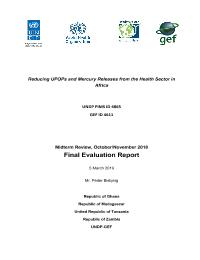
Mid-Term Evaluation: Reducing UPOPs and Mercury releases from the Health Sector in Ghana
Output 1.4.1 Solutions scaled up for sustainable management of natural resources, including sustainable commodities and green and inclusive value chains
Goal 12. Ensure sustainable consumption and production patterns
Goal 17. Strengthen the means of implementation and revitalize the Global Partnership for Sustainable Development
12.4 By 2020, achieve the environmentally sound management of chemicals and all wastes throughout their life cycle, in accordance with agreed international frameworks, and significantly reduce their release to air, water and soil in order to minimize their adverse impacts on human health and the environment
17.16 Enhance the Global Partnership for Sustainable Development, complemented by multi-stakeholder partnerships that mobilize and share knowledge, expertise, technology and financial resources, to support the achievement of the Sustainable Development Goals in all countries, in particular developing countries
1: Others
2: Sustainable



This is a regional programme that comprising four countries: Ghana, Zambia, Tanzania and Madagaca. It will be evaluated from the regional level.